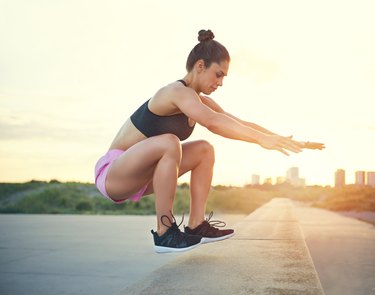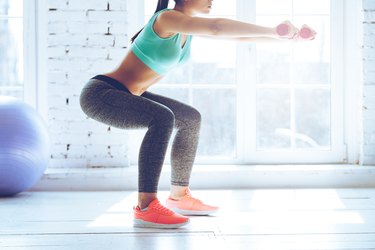
Squatting, like every exercise, comes with an inherent risk of injury. However, this risk is typically rooted in poor technique, lifting too-heavy weights or continuing to attempt to lift despite fatigue. Start with bodyweight squatting first, meaning that you're not doing the movement with any weight, such as a barbell or dumbbell. Before you decide to put a barbell over your shoulders, practice your technique with a broomstick to ensure good control through a full range of motion.
The Risk to Your Lower Back
Video of the Day
When you experience lower back pain after squatting, it's probably s result of a forward lean during the move, the hips coming up too soon or rounding your back. All of these can be avoided by properly strengthening the muscles that support your torso, which are your abdominals and lower back. Additional work with light weight to build good technique should allow you to squat heavy weights without rounding or forward lean. Squatting properly develops the strength of your spine, according to a study in the International Journal of Sports Medicine.
Video of the Day
Read More: Squats and Lower Back Posture

Pain in the Knees
There is a great debate about the safety of squatting and the effect on your knee joints. Squatting with poor technique, allowing your knees to move in and out while you are moving up and down, is a recipe for disaster. Collapsing into the bottom of the squat is also an issue, but not the fault of the exercise itself. Powerlifters and weightlifters, both of whom squat extensively — and heavily — exhibit very few knee injuries. A study in the American Journal of Sports Medicine revealed that knee injuries, though rare, were slightly more prevalent in weightlifters. Weightlifters also perform the snatch and the clean and jerk, movements that subject the knee to more stress than the squat.
A Burden on the Shoulders
Allowing the bar to roll down your back can hurt your shoulders. This can be avoided by not putting anything between yourself and the bar. Padding not only raises your center of gravity, forcing you to work harder to balance the bar, it leaves less of the bar in contact with your upper back. The more of the bar that is in contact with your body, the greater the friction to help hold it in place. To keep the bar firmly fixed, pull your elbows down and then pull your hands forward, as if you were trying to bend the bar over your back.
Risk of Getting Stuck
Getting stuck under the bar is a valid concern, because sooner or later you will miss a lift. This is why you should never squat outside of a power rack or squat cage. Set the pins or rack high enough that they are just below the level of the bar at the bottom of your squat. If you need to dump the bar off of your back, dump it backward, to avoid leaning forward with the squat.
Read More: What Muscles Do Squats Target?